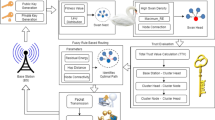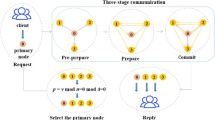Abstract
Secure data aggregation exerts more and more important effects on the research of wireless sensor network. There occurs many groping research subject, via managing nodes’ trust and reputation to keep data aggregation secure. The nodes in wireless sensor networks are often compromised and those compromised nodes will do a lot of harmful behaviors to decrease the security of wireless sensor networks. These behaviors include impersonate legal nodes to join routing paths, selectively forward data to an adversary, inject erroneous data, and disrupt data transmission. Thus, the conception of nodes’ trust is introduced into data aggregation to judge and evaluate whether the nodes are trustable or not. In this paper, we propose an improved trust management method for data aggregation based on the relationship between nodes that is called the strength of the ties between the nodes. The improved method is developed from the trust model in the iRTEDA protocol and increasing the utilization efficiency of second-hand information coming from neighboring nodes. The aim of the proposed trust model is to obtain a higher level of security for data aggregation. The simulation results show us that data aggregation, based on proposed trust management method, can get higher accuracy of evaluating nodes’ trust and reputation and achieve higher data accuracy of aggregating.




Similar content being viewed by others
References
Akyildiz, I. F., Weilian, S., Sankarasubramaniam, Y., & Cayirci, E. (2002). A survey on sensor networks. IEEE Communications Magazine, 40(8), 102–114.
Culler, D., Estrin, D., & Srivastava, M. (2004). Guest editors’ introduction: overview of sensor networks. IEEE Computer, 37(8), 41–49.
Yu, J., Yang, J., & Wang, H. (2014). Fault detection for large-scale railway maintenance equipment base on wireless sensor networks. Sensors & Transducers, 169, 1726–5479.
Akkaya, K., Demirbas, M., & Aygun, R. S. (2008). The impact of data aggregation on the performance of wireless sensor networks. Wireless Communications and Mobile Computing, 8(2), 171–193.
Rajagopalan, R., & Varshney, P. K. (2006). Data aggregation techniques in sensor networks: A survey. IEEE Communications Surveys and Tutorials, 8(4), 48–63.
Zhang, Z. J., Lai, C. F., & Chao, H. C. (2014). A green data transmission mechanism for wireless multimedia sensor networks using information fusion. Wireless Communications, IEEE, 21(4), 14–19.
Yick, J., Mukherjee, B., & Ghosal, D. (2008). Wireless sensor network survey. Computer Networks, 52(12), 2292–2330.
Ozdemir, S., & Xiao, Y. (2009). Secure data aggregation in wireless sensor networks: A comprehensive overview. Computer and Networks, 53(12), 2022–2037.
Li, H., Lin, K., & Li, K. (2011). Energy-efficient and high-accuracy secure data aggregation in wireless sensor networks. Computer Communications, 34(4), 591–597.
Roy, S., Conti, M., Setia, S., et al. (2012). Secure data aggregation in wireless sensor networks. IEEE Transactions on Information Forensics and Security, 7(3), 1040–1052.
Roy, S., Conti, M., Setia, S., et al. (2014). Secure data aggregation in wireless sensor networks: Filtering out the attacker’s impact. IEEE Transactions on Information Forensics and Security, 9, 681–694.
Ganeriwal, S., & Srivastava, M. (2004). Reputation based framework for high integrity sensor networks, In Procedings of the 2nd ACM Workshop on Security of Ad Hoc and Sensor Networks, (pp. 66–77).
Ganeriwal, S., Balzano, L. K., & Srivastava, M. (2008). Reputation based framework for high integrity sensor networks. ACM Transactions on Sensor Networks, 4(3), 1–37.
Srinivasan, A., Teitelbaum, J., Liang, H., Wu, J., & Cardei, M. (2008). Reputation and trust-based systems for Ad Hoc and sensor networks. In A. Boukerche (Ed.), Algorithms and Protocols for Wireless Ad Hoc and Sensor Networks. Chichester: Wiley.
Shaikh, R.A., Jameel, H., Lee, S., Rajput, S., & Song, Y. J. (2006). Trust management problem in distributed wireless sensor netowkrs. In Proceedings of the 12th IEEE Conference on Embedded and Real-Time Computing Systems and Applications, RTCSA’06 (pp. 411–414). Sydney, Australia.
Ozdemir, S. (2008). Functional reputation based data aggregation for wireless sensor networks. In IEEE International Conference on Wireless & Mobile Computing, Networking & Communication (pp. 592–597).
Ozdemir, S. (2008). Functional reputation based reliable data aggregation and transmission for wireless sensor networks. Computer Communications, 31(17), 3941–3953.
Liu, C.-X., Liu, Y., & Zhang, Z.-J. (2013). Improved reliable trust-based and energy-efficient data aggregation for wireless sensor networks. International Journal of Distributed Sensor Networks, 2013(652495), 11. doi:10.1155/2013/652495.
Granovetter, M. S. (1973). The strength of weak ties. American Journal of Sociology, 78(6), 1360–1380.
Onnela, J. P., Saramaki, J., et al. (2007). Structure and tie strengths in mobile communication networks. Proceedings of the National Academy of Sciences, 104(18), 7332–7336.
Josang, A., & Ismail, R. (2002). The beta reputation system. In Proceedings of the 15th Bled Conference Electronic Commerce (p. 41).
Acknowledgments
This research is supported by the National Natural Science Foundation of China Under Grants 61071076, Beijing Natural Science Foundation Under Grants 4132057, National High-tech Research And Development Plans (863 Program) Under Grants 2011AA010104-2, Fundamental Research Funds for the Central Universities (2015YJS027), The Academic Discipline and Postgraduate Education Project of Beijing Municipal Commission of Education.
Author information
Authors and Affiliations
Corresponding author
Rights and permissions
About this article
Cite this article
Liu, Y., Liu, Cx. & Zeng, QA. Improved trust management based on the strength of ties for secure data aggregation in wireless sensor networks. Telecommun Syst 62, 319–325 (2016). https://doi.org/10.1007/s11235-015-0078-6
Published:
Issue Date:
DOI: https://doi.org/10.1007/s11235-015-0078-6




